![]() Knutsen
Harp Bandurria
Knutsen
Harp Bandurria ![]()
by Gregg Miner, as part of

|
|
||
|
by Gregg Miner, as part of |
 |
|
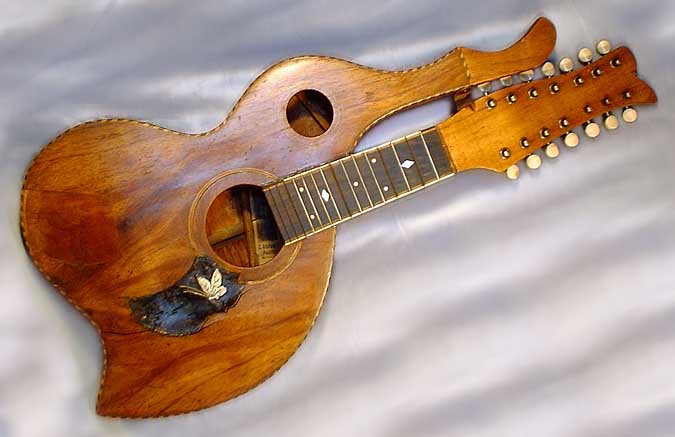 |
This incredible instrument, hanging in a private home for the past thirty years, came to my attention in February, 2003. It appears to be all original (except for a top repair patch), but unfortunately is missing the nut and bridge. Luckily, it was well played, as the heavy fret wear from the strings provides the only clue as to the original stringing. However, I still can’t say with absolute certainty what instrument Knutsen intended it to be, nor how he originally tuned it. |
At first glance, it appeared to be a 14-string harp mandolin with a
shorter neck. While 12-string mandolins (three strings per course) were once a
somewhat common variation, the two additional strings on this would seem
superfluous. Neither did the scale length of 12" match up with Knutsen’s
mandolins (normally 13-3/4" to 14"). Nor did I suspect Knutsen of
attempting the rare piccolo mandolin with so many strings (and which have
a 10" scale besides). My only hope (and thought) was "please let
there be fret wear!" Alan Frazier, the owner, gamely threw himself into
the investigation by photographing the frets through a 50 power microscope to
look for any telltale grooves created by the strings. Unfortunately, it turned
out that someone had filed down the frets toward the treble side, erasing much
of the evidence. However, with a reference ruler included, I was able to
assemble the entire third fret in Photoshop and, after some lengthy
number-crunching, calculate with a high degree of probability the arrangement
(and even gauges) of the original strings (presented below). Finally, after much
careful consideration - including the unusual length of the neck, the number of
strings, and now the string layout (6 courses) - I concluded that this
instrument was most likely Knutsen’s version of the well-known Spanish bandurria.
As it differs from the traditional bandurria in a couple of ways (besides the
obvious Knutsen harp-mandolin shape), let me explain my line of reasoning by
discussing clues provided by historical context, and the features of bandurrias
(and relatives) themselves.
Historical Context
The bandurria is the instrument played by the infamous "Spanish Students," a touring group who took our country by storm in 1880 and ultimately inspired the subsequent Mandolin Orchestra craze. As the bandurria was considered a musical counterpart to the mandolin, Americans chose to simply use the Neapolitan mandolin (and later flat- or arched-back mandolins) to recreate the sound in mandolin clubs and orchestras. Even so, the bandurria was well enough known that some American manufacturers made them on a custom or limited basis. Specifically (and Readers, please let me know of any others).
The Martin Company built three of them in 1904 for a San Francisco
retailer.
Lyon & Healy built the Lakeside brand bandurria in my collection –
the Lakeside name dating it from approximately 1900 to the mid ‘twenties.
And, perhaps most significant to our story, Knutsen's Los Angeles
neighbors during the same time period, The Schireson Brothers, built
bandurria and laud-type instruments ca. 1911-1920s. The Spanish laud is similar, but
tuned an octave lower, and traditionally has f-holes surrounding
a teardrop-shaped soundhole. The six courses are sometimes tripled (18
strings total).
|
Lakeside bandurria. Scale length 10-1/4", nut width 2", 12 frets. Early 1900's. |
A Schireson Brothers "Lyric" laud with 18 strings on the left, and a traditional Spanish laud with 12 strings on the right. From the collection of Kerry Char. (image copyright Kerry Char) |
A strange, 18-string (6 triple courses) Lyric brand bandurria-like instrument built by The Schireson Bros. ca. 1911-1920s. From the collection of Gary Schireson. |
|
And now Knutsen. It seems unlikely that Knutsen would have been completely unaware of these instruments – especially those of the Schireson Brothers, who were just a few blocks from Knutsen when this instrument may have been built (based on the label)! Whether a commissioned instrument or another of his wild experiments, the plethora of strings on yet another strange design must have been irresistible to Knutsen. |
||
|
Instrument Features The bandurria dates back to at least 1555, at which time it was a 3-string instrument. It evolved into it’s final state (6 courses and metal strings) by the late 1800’s, and is still being made today in Spain in the same style (and played – 600 ensembles in Valencia province alone). Incidentally, it seems to have evolved independently as a guitar-mandolin hybrid, and not as a descendant of the mandolin nor the cittern (as the superficially similar Portuguese guitarra did). The traditional bandurria has six courses of double strings (totaling 12). It has a squat, deep, pear-shaped body with an extremely short neck accommodating from 12 to 14 frets. Scale length varies from 10" to 11." Unlike mandolins, citterns and Portuguese guitarras, the strings (originally gut, now metal) usually attach to a bridge glued to the top, not a tailpiece. Tunings can vary, the most common utilizing all fourths, from g’# to a’’ (enabled by the very short scale). Interestingly, 13 & 14-string variations also occur (certain courses are tripled) in the form from the Philippines. Here is a typical Philippine 14-string version, with 6 courses arranged in a 1-2-2-3-3-3 pattern. |
|
|
In certain South American countries, the instrument has become the bandola, which traditionally has sixteen strings. These are also tuned in six courses, with the four highest courses tripled. The bandola in my collection (at right) has this stringing on a neck with 16 frets and a scale length of just over 13". Tunings vary, but fourths are again typical (a whole step below the bandurria now being "standard"). Not in any literature, but LaBella makes, in addition to a 16-string, 6-course bandola string set (gauged .043-.008", ), a 14-string, 5-course bandola set (simply dropping the 6th double course). In either case, the four highest courses are tripled. Could this instrument be the 14-string Philippine-form bandurria referred to above? Colombian bandola. Scale length 13-1/16", nut width 2-1/16", 16 frets. |
|
| The Knutsen instrument has fourteen strings arranged in six courses. But what a strange arrangement! The tripled strings may have occurred on the fifth and sixth courses, or perhaps more likely, on the first and fifth courses. Regardless, the tripled fifth course is definite - but whereas in bandurrias and bandolas the strings within courses are tuned in unison, Knutsen’s fifth course consists of two low (normal) strings with a high octave string. Finally, where bandurrias’ 6th-1st courses are tuned low-to-high, Knutsen’s 6th course (whether double or triple) seems to have been strung and tuned an octave higher than normal (as in a ukulele re-entrant tuning). It’s as if he was asked (or chose) to build a combination of bandurria, tiple and mandolin. Nevertheless, I am sticking with "harp bandurria" as this remains the most similar instrument when all the evidence is weighed. | |

|
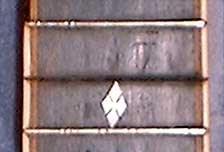 |
|
|
At top left is the 3rd fret composite image showing what's left of the 6 courses, evident in the wear. In the right image, note that the wear on the fingerboard from the player’s fingernails occurs between the six courses – as expected from typical fretting technique/finger placement. Finally, a mathematically accurate drawing, according to my calculations, of the proposed original nut – including spacing and approximate gauging of the strings. The missing, assumed strings are in red.
Option 1: 1st and 5th courses tripled;
more evenly and correctly spaced; fits the scenario of filing down
towards the treble side, leaving the bass side alone. |
||
| Knutsen’s instrument has a 12" scale with 15 frets – somewhere between a traditional bandurria and bandola. He deviates from the traditional glued bridge and uses his mandolin tailpiece system instead. For this scale comparison with a typical Knutsen harp mandolin, I have used Photoshop to "restore" the missing nuts, frets and bridge to more easily evaluate the differences. |
Left: HBA1, Right: HM1. |
Harp Bandurria | Harp Mandolin | |
| Courses: | 6 | 4 | ||
| Scale: | 12" | 13-7/8" | ||
| Frets: | 15 | 18 | ||
| Nut width: | 2-1/8" | 1-3/16" | ||
| Body width: | 12" | 11-1/4" | ||
| Soundhole diameter: | 3-1/8" | 2-7/16" | ||
| Total length: | 25+" | 24-1/2" |
Sources: Martin Guitars: Washburn & Johnston, 1997; European & American Musical Instruments: Anthony Baines, 1966; The Oxford Companion to Musical Instruments: A. Baines, 1992; Cataloque of Musical Instruments in the Victoria & Albert Museum: A. Baines, 1998, A Survey of Musical Instruments: Sybil Marcuse, 1975, Randy Osborne of Fine Fretted Instruments, pers. comm., Kerry Char, pers. comm.
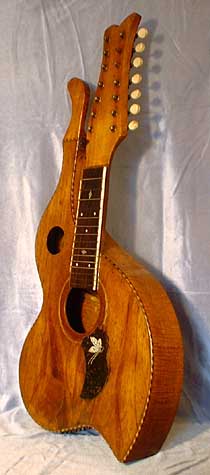 |
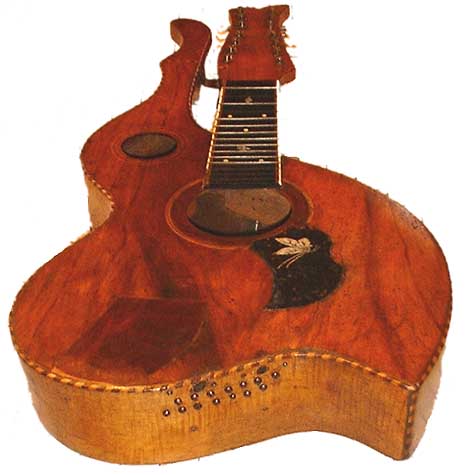 |
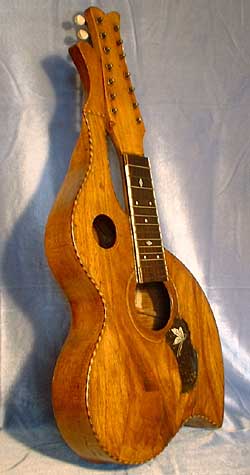 |
|
|
|
Click on a picture to
enlarge
(all images of HBA1 copyright Alan Frazier, all other images copyright Gregg Miner)
|
Knutsen Archives Inventory Number |
HBA1 |
|
|
Category |
Harp Bandurrias |
|
|
Body Style |
"Lower Treble Point" |
|
|
Current or last known owner |
Alan & Rachelle Frazier |
|
|
Year (approx) |
1914-1920s |
|
|
Label |
New Hawaiian Family half-label, white |
|
|
Courses / Strings |
6 courses: 14 strings |
|
|
Scale length |
12" |
|
|
Woods |
Top |
koa |
|
Back & Sides |
flame maple |
|
|
Neck |
unknown |
|
|
Fingerboard |
dyed ? |
|
|
Bridge |
missing |
|
|
Headstock veneer |
none |
|
|
Binding, trim |
Top |
rope |
|
Back |
none |
|
|
Fingerboard |
ivoroid |
|
|
Headstock(s) |
none |
|
|
Soundhole |
colored wood |
|
|
Inlay |
fancy pearl fret markers |
|
|
Pickguard |
unknown with pearl inlaid butterfly |
|
|
Comments |
Missing nut, bridge and tailpiece. Patch repair in top. |
|
[Biographical]
[Instruments]
[Historical
Photos]
[Credits]
[FAQ]
[Bibliography]
[Updates]
[Links]
[Contact]
[Home
(Knutsen Archives)] [Home
(Harpguitars.net)]
All Site Contents Copyright © Gregg Miner, 2002, 2003, 2004, 2005,2006,2007,2008,2009,2010,2011,2012,2013,2014,2015,2016. All Rights Reserved.
Copyright and Fair Use of material and use of images: See Copyright and Fair Use policy.